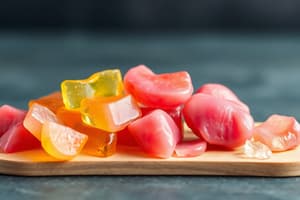Podcast
Questions and Answers
What is the recommended amount of sunscreen (in mg/square cm) for effective protection?
What is the recommended amount of sunscreen (in mg/square cm) for effective protection?
- 2 mg/square cm (correct)
- 4 mg/square cm
- 1 mg/square cm
- 3 mg/square cm
Which vitamin is known for its skin-lightening effects?
Which vitamin is known for its skin-lightening effects?
- Vitamin E
- Vitamin C (correct)
- Vitamin A
- Biotin
Which vitamin is important for decreasing sebum production?
Which vitamin is important for decreasing sebum production?
- Vitamin B6 (correct)
- Vitamin D
- Vitamin A
- Beta-Carotene
What type of protection does Vitamin D provide?
What type of protection does Vitamin D provide?
Which vitamin, when combined with Vitamin E, provides protection from UVB damage?
Which vitamin, when combined with Vitamin E, provides protection from UVB damage?
In what way does Vitamin A benefit the skin?
In what way does Vitamin A benefit the skin?
Which type of fatty acids are usually used in skincare products due to their stability?
Which type of fatty acids are usually used in skincare products due to their stability?
What is the term for substances that attract water and prevent drying of preparations?
What is the term for substances that attract water and prevent drying of preparations?
Which component is employed in skincare products as a skin protectant?
Which component is employed in skincare products as a skin protectant?
Which active ingredient is effective for acne-prone skin?
Which active ingredient is effective for acne-prone skin?
What type of pigments are formed by precipitating a thin layer of color on thin platelets of mica?
What type of pigments are formed by precipitating a thin layer of color on thin platelets of mica?
What substance is commonly used in gels and also found in foods?
What substance is commonly used in gels and also found in foods?
What determines the difference between a cosmetic and a drug?
What determines the difference between a cosmetic and a drug?
Which term refers to products used for hair, body, and teeth?
Which term refers to products used for hair, body, and teeth?
What does the claim 'hypoallergenic' imply?
What does the claim 'hypoallergenic' imply?
What does the claim 'cruelty-free' indicate?
What does the claim 'cruelty-free' indicate?
Why are preservatives added to cosmetic products containing water?
Why are preservatives added to cosmetic products containing water?
What do cosmeceuticals generally advertise to contain?
What do cosmeceuticals generally advertise to contain?
What is the main function of preservatives in cosmetics?
What is the main function of preservatives in cosmetics?
What is the definition of cosmetics according to the ASEAN Consumer Information Handbook on Cosmetic Product?
What is the definition of cosmetics according to the ASEAN Consumer Information Handbook on Cosmetic Product?
Which of the following additives is used to adjust the pH of cosmetic formulations?
Which of the following additives is used to adjust the pH of cosmetic formulations?
What is the main purpose of plasticizers in cosmetics?
What is the main purpose of plasticizers in cosmetics?
Which statement accurately describes cosmetic science?
Which statement accurately describes cosmetic science?
Which of the following is NOT a propellant commonly used in aerosol preparations?
Which of the following is NOT a propellant commonly used in aerosol preparations?
What is a primary objective of cosmetic products?
What is a primary objective of cosmetic products?
Which of the following is NOT mentioned as a component in cosmeceuticals?
Which of the following is NOT mentioned as a component in cosmeceuticals?
What is the primary function of silicone blends of dimethicone gums or resins in cosmetics?
What is the primary function of silicone blends of dimethicone gums or resins in cosmetics?
Why are UV filters important in cosmetics?
Why are UV filters important in cosmetics?
What distinguishes cosmetic products from drug products?
What distinguishes cosmetic products from drug products?
Which term best describes the use of glutathione in cosmetics?
Which term best describes the use of glutathione in cosmetics?
Flashcards are hidden until you start studying
Study Notes
Introduction to Cosmetic Formulation
- Cosmetic science is a multidisciplinary field that encompasses concepts and principles from different fields of science.
- Cosmetics are defined as substances or preparations intended to be placed in contact with external parts of the human body to clean, perfume, change appearance, correct body odors, protect, or keep them in good condition.
Cosmetic vs. Drug
- A cosmetic differs from a drug in its intended use, not by the ingredients or amount of active ingredients.
- Consumer perception also plays a role in distinguishing between cosmetics and drugs.
Terms in Cosmetic Formulation
- Cosmeceuticals: multi-function products containing bioactive ingredients, can be purchased as cosmetics and advertised to have specific benefits.
- Personal care products: products used for hair, body, and teeth, also referred to as toiletries.
- Hypoallergenic: products that claim to produce fewer allergic reactions, but do not guarantee zero allergic reactions.
- Cruelty-free: products that use alternative methods to animal experiments for safety testing, but do not necessarily mean vegan.
- Preservative-free: products that replace water with higher percentages of alcohol or have a pH that prevents microbial growth.
Emollients
- Emollients are used to replenish oils and lipids in the skin.
- Types of emollients: animal-based (e.g. stearic acid, palmitic acid), vegetable-based (e.g. coconut oil, palm-kernel oil), and petroleum-based (e.g. petrolatum, mineral oil).
- Long-chain alcohols are useful as emollients and emulsion stabilizers.
- Esters of fatty alcohols and fatty acids make excellent emollients.
Moisturizers
- Moisturizers add or retain moisture in the skin.
- Subclasses of moisturizers:
- Humectants: hygroscopic, prevents drying of preparations (e.g. glycerin, sorbitol, urea, propylene glycol).
- Emollients: replenish oils and lipids in the skin.
- Occlusives: hydrophobic, keeps moisture in (e.g. petrolatum, mineral oil, paraffin, carnauba or candelilla waxes).
- Enhancers of the Skin Barrier: skin rejuvenators, enhance barrier function of the skin (e.g. collagen, keratin, elastin).
Waxes and Thickeners
- Waxes: long chain FA, solid at room temperature, has sealing properties (e.g. beeswax).
- Thickeners:
- Cellulose: swells in hot water.
- Carbopol: swells when neutralized.
- Bentonite Clays: swells.
- Carrageenan: used in foods, usually employed in gels.
- Pectin: usually employed in gels.
- Locust Bean: for flavoring.
Active Ingredients
- Acts physiologically to lighten, tighten, and firm the skin.
- Examples:
- Fruit Acids (e.g. alpha-hydroxy acids).
- Aluminum Chlorohydrate: employed as an antiperspirant.
- Salicylic Acid: used for acne-prone skin.
- Benzoyl Peroxide: used for acne-prone skin.
- Dimethicone: skin protectant.
- Petrolatum: skin protectant.
Pigments and Dyes
- Pigments: incorporated to impart color.
- Examples:
- Face Powders: blending inorganic oxides with fillers.
- Fillers: inert, inexpensive materials (e.g. kaolin, talc, silica, mica).
- Eye shadows, Blushers, and Lipsticks: oils, zinc stereate.
- Pearlescent Pigments: formed by precipitating a thin layer of color on thin platelets of mica.
- Organic Pigments: lacks precipitating salt.
Preservatives and Antioxidants
- Preservatives: prevent microbial contamination and rancidity.
- Examples:
- Parabens.
- Phenoxyethanol.
- Antioxidants: prevent formations of free radicals in the skin.
- Examples:
- Vitamin E (alpha-tocopherol).
- Butylated hydroxytoluene (BHT).
Other Additives
- pH Buffers: to match the formulation's pH with that of the application surface.
- Examples:
- Citric acid.
- Lactic acid.
- Sodium hydroxide.
- Triethanolamine.
- Plasticizers: added to films to soften and impart flexibility.
- Examples:
- Camphor.
- Castor oil.
- Glycerin tribenzoate.
- Propellants: added to aerosol preparations to maintain pressure and help expel contents.
- Examples:
- Isopentane (liquified gas).
- Butane.
- Sobutane.
- Propane.
Solvents
- Polar solvents: water, glycerin, propylene glycol.
- Semi-polar solvents: ethanol, isopropyl alcohol, acetone, ethyl acetate.
- Non-polar solvents: mineral oil, petrolatum, flower oils, seed oils, hexane, toluene, dimethyl ether.
Physical Absorption
- UV Filters:
- PABA Derivatives (e.g. octyl dimethyl PABA).
- Cinnamates (e.g. octyl methoxycinnamate).
- Salicylates (e.g. weak UVB absorber).
- Benzophenones (e.g. poor stability, used less frequently).
- Avobenzone (e.g. UVA absorber, not photostable).
- Titanium dioxide (e.g. broad spectrum, non-irritant, amphiphilic).
- Zinc oxide (e.g. 200 nm particle size appears transparent, less whitening).
Vitamins
- Vitamin E: non-enzymatic antioxidant, alpha-tocopherol acetate ester converted to tocopherol in the skin.
- Vitamin C: water-soluble non-enzymatic antioxidant, protects from UVB damage if combined with Vitamin E.
- Vitamin A: stimulates cell proliferation and cell renewal, increases collagen content of the dermis, and increases elasticity and barrier function of the skin.
- Biotin: good for nails and hair due to effect on keratinization.
- Vitamin D: UV barrier.
- Vitamin B6: for decreasing sebum protection.
- Beta-Carotene: partnered with Vitamin E and C to protect the skin against UV damage.
Studying That Suits You
Use AI to generate personalized quizzes and flashcards to suit your learning preferences.




